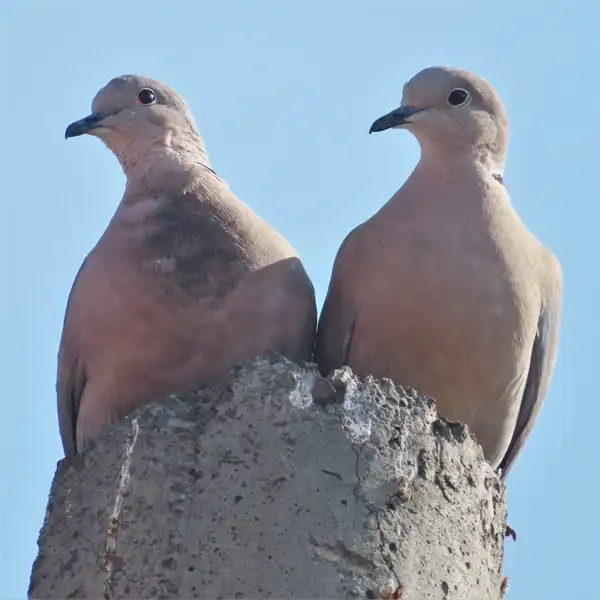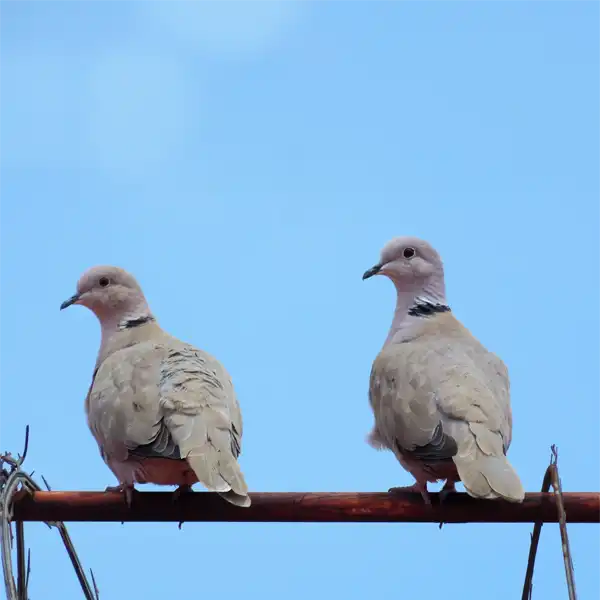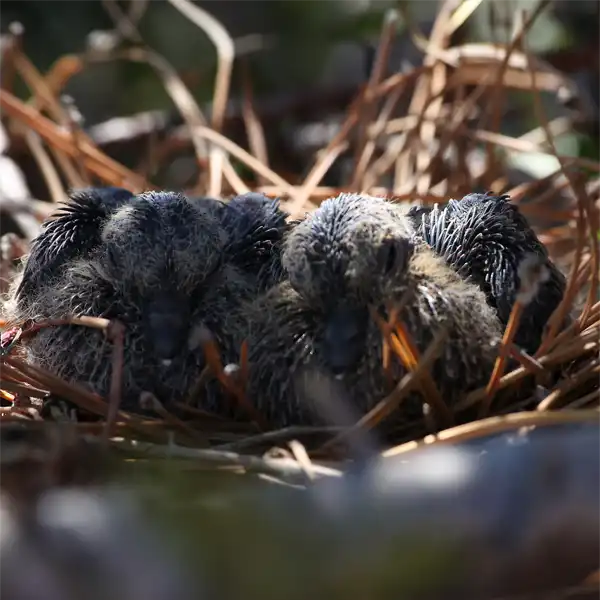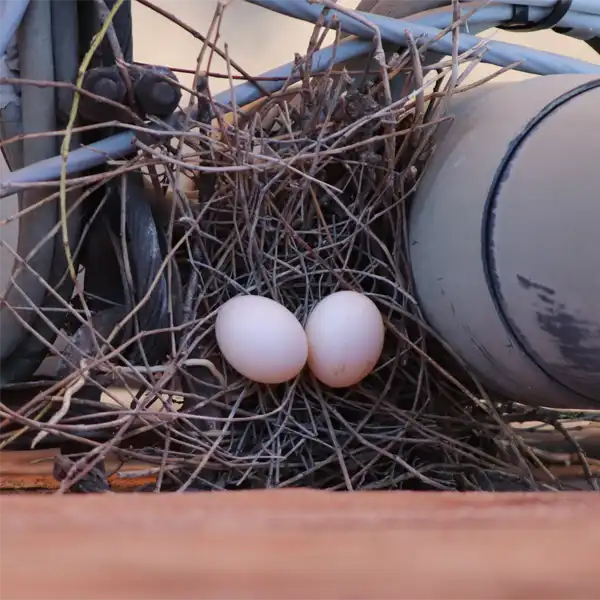Eurasian Collared Dove
- Scientific Name
- Streptopelia decaocto
- Also Known As
- Eurasian Collared-Dove, Collared Dove
- Range
- All of Florida
- Diet
- Grain, Seeds, Insects
- Life Expectancy
- 2 - 5 Years
Quick Links
Eurasian Collared Doves in Central Florida
The Eurasian collared dove (Streptopelia decaocto) is an invasive dove species that has rapidly expanded its range across North America over the past few decades. As an adaptable generalist, the Eurasian collared dove thrives in urban and agricultural areas like central Florida.
This comprehensive guide provides identification tips, biology facts, and prevention methods for Eurasian collared doves in central Florida. Read on to learn about Eurasian collared dove habits, reproduction, diet, health risks, signs of infestation, and professional control options if you want to manage their populations.
Appearance and Identification
Eurasian collared doves can be identified by their distinct physical characteristics
Eurasian collared doves are larger than native mourning doves and lack the mourning dove’s long tail feathers. They are also lighter in color than introduced rock pigeons. Their black and white collar distinguishes them from other doves when seen up close.
Maturation Rate
Eurasian collared doves develop rapidly due to their high reproductive output. Chicks grow flight feathers and leave the nest just 15-19 days after hatching. They reach adult size within 4-6 weeks but may continue begging from parents for resources.
At two months of age, young Eurasian collared doves can begin breeding and produce their own offspring. Such fast maturation enables exponential population growth and exploitation of diverse habitats.
Habits and Behavior
Eurasian collared doves are ground feeders that walk on land more than native mourning doves. They are also less wary of humans and will nest in close proximity to human habitation.
Eurasian collared doves are monogamous and form long-term pair bonds. Both parents participate in rearing young. They are non-migratory but may relocate based on food availability. Their cooing, rolling calls are lower-pitched than the mourning dove.
Reproduction and Lifespan
Eurasian collared doves are prolific breeders and can raise up to 6 broods per year in warm climates like central Florida. The male displays and offers the female sticks and vegetation to initiate breeding. The female builds a flimsy platform nest, laying 1-2 white eggs that incubate for 14-18 days.
The chicks fledge after 15-19 days but remain dependent on the parents for up to two weeks after leaving the nest. Eurasian collared doves have remarkably short intervals between breeding cycles, sometimes nesting again while still feeding fledglings.
Lifespans are typically 2-5 years but rarely exceed 10 years in the wild. Their high reproduction rate allows for rapid population expansion and range spread.
Ideal Habitat and Range
The warm, subtropical climate of central Florida provides ideal conditions for Eurasian collared doves year-round. Average temperatures range from the 60s°F (15-20°C) in north Florida to the 70s°F (21-26°C) in south Florida, only dropping below freezing a few days per year. Annual rainfall ranges from 40-65 inches (1000-1600 mm).
These temperate conditions allow near constant breeding. Food sources like agricultural crops, bird seed, spilled grain from livestock feed lots, and landscaping plants provide abundant nutrients. Eurasian collared doves additionally tolerate urban areas and will nest on human structures when tree cavities are unavailable.
The high reproduction, rapid maturation, sedentary nature, and generalist diet of Eurasian collared doves facilitates their proliferation across central Florida’s favorable climate and habitats. Their populations will likely continue expanding given the region’s ample resources.
Diet and Feeding
Eurasian collared doves exploit a wide range of food sources, contributing to their success as an invasive species. Their diet consists mainly of:
- Cereal grains – corn, wheat, rice, oats, millet
- Legumes – peas, beans, peanuts
- Seeds and fruits – berries, soft mast
- Supplementary insects – beetles, caterpillars
They forage primarily on the ground in open habitats like lawns, agricultural fields, and roadsides. Spilled grain from feed lots and bird seed from yards provide easy calories. Eurasian collared doves can meet their nutritional needs on abundant, widely available foods in central Florida.
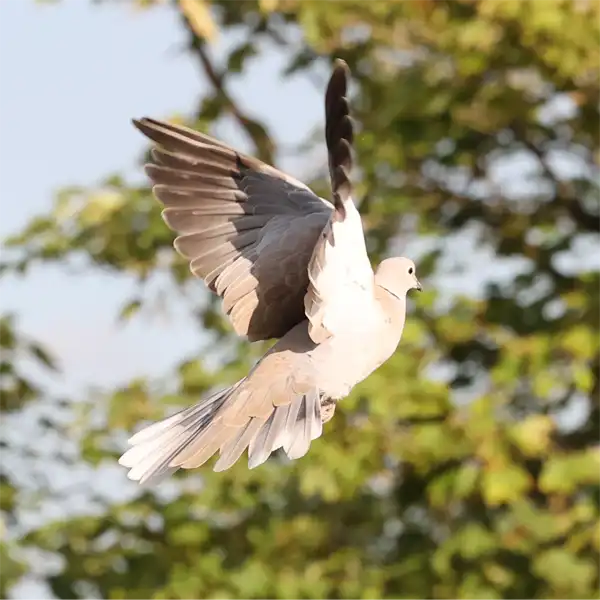
Photo 316198069 © Croftylock, CC BY-NC

Common Health Risks
Eurasian collared doves pose some potential health risks:
- Histoplasmosis – Can spread fungal spores by disturbing contaminated soil. Causes flu, pneumonia.
- Ectoparasites – Feather mites and lice can spread to humans by direct contact. Not common.
- Cryptococcosis – Can spread fungal spores in droppings. Very rare infection.
- Psittacosis – Can transmit Chlamydophila psittaci bacteria through droppings. Causes flu symptoms. Uncommon to be transferred to humans.
Overall risks to human health are relatively low. Allergies may be aggravated from the spread of feathers and droppings when populations are high. Maintaining sanitation around nesting areas helps reduce exposure to associated parasites and microbes.
Preventing Eurasian Collared Doves
As an invasive species, methods to discourage and exclude Eurasian collared doves may help reduce their ecological impact and conflicts:
- Remove food sources – Clean up spilled bird seed and grain. Secure trash in sealed bins.
- Modify landscaping – Reduce dense cover for nests. Use bird deterrents on ledges.
- Seal openings – Block access to nesting and roosting spaces in buildings.
- Remove nests – Humanely destroy unwanted nests on structures.
- Deterrents – Use visual or auditory deterrents where nesting occurs.
- Population control – Culling overabundant populations may be warranted in some cases to protect native species. Seek professional guidance.
Completely eliminating established Eurasian collared dove populations is unrealistic. But exclusion, deterrents, and population management can help restrict further spread and reduce local abundances.
Eurasian Collared Doves in Central Florida – Conclusion
In summary, Eurasian collared doves are adapted to thrive in central Florida’s warm climate, urban habitats, and agricultural lands. While they pose minimal risks to human health and welfare, their invasive spread may negatively impact native wildlife. Therefore, proactive steps like modifying habitat, securing food sources, and excluding nesting sites can help reduce their proliferation.
Combined with population management when warranted, these measures may improve ecological balance with native species. But Eurasian collared doves are likely a permanent addition to central Florida’s avian assemblage given the region’s hospitable conditions.

